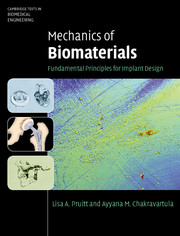Book contents
- Frontmatter
- Contents
- Symbols
- Prologue
- Part I Materials
- 1 Biocompatibility, sterilization, and materials selection for implant design
- 2 Metals for medical implants
- 3 Ceramics
- 4 Polymers
- 5 Mechanical behavior of structural tissues
- Part II Mechanics
- Part III Case studies
- Epilogue
- Appendix A Selected topics from mechanics of materials
- Appendix B Table of material properties of engineering biomaterials and tissues
- Appendix C Teaching methodologies in biomaterials
- Glossary
- Index
- References
1 - Biocompatibility, sterilization, and materials selection for implant design
from Part I - Materials
Published online by Cambridge University Press: 05 June 2012
- Frontmatter
- Contents
- Symbols
- Prologue
- Part I Materials
- 1 Biocompatibility, sterilization, and materials selection for implant design
- 2 Metals for medical implants
- 3 Ceramics
- 4 Polymers
- 5 Mechanical behavior of structural tissues
- Part II Mechanics
- Part III Case studies
- Epilogue
- Appendix A Selected topics from mechanics of materials
- Appendix B Table of material properties of engineering biomaterials and tissues
- Appendix C Teaching methodologies in biomaterials
- Glossary
- Index
- References
Summary
Inquiry
All medical implants must be sterilized to ensure no bacterial contamination to the patient. How would you sterilize a total hip replacement comprising a titanium stem, a cobalt-chromium alloy head, and an ultra-high molecular weight polyethylene acetabular shell? Could the same method be employed for all three materials? How do you ensure that there is no degradation to the material or its structural properties? What factors would you need to consider in the optimization of this problem?
The inquiry posed above represents a realistic challenge that one might face in the field of orthopedic biomaterials. At a minimum, one would want to know the sterilization methods available for medical implants and which materials they best serve. For example, steam or autoclaving work well for sterilization of metals and ceramics but are generally unsuitable for polymers due to the lower melting and distortion temperatures of medical plastics. Also, one needs to consider whether there are any changes in the mechanical properties or if any time-dependent changes are expected owing to the sterilization method employed; for example, gamma radiation is known to leave behind free radicals (unpaired electrons) and these free radicals are highly reactive with elements such as oxygen that may be present or may diffuse into the implant material. In certain polymer materials such as ultra-high molecular weight polyethylene, gamma radiation can result in oxidation-induced embrittlement (shelf aging) that can severely degrade its wear and fracture properties. The case study presented at the end of this chapter addresses this issue.
Historical perspective and overview
Designing medical implants is a complex process, and this textbook aims to provide insight into the material, mechanical, and clinical factors that affect implant design and performance. The goal of this book is to integrate all aspects of implant design including clinical issues, structural requirements, materials selection, and processing treatments.
- Type
- Chapter
- Information
- Mechanics of BiomaterialsFundamental Principles for Implant Design, pp. 3 - 25Publisher: Cambridge University PressPrint publication year: 2011

